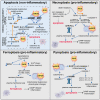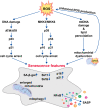Oxidative stress as a key modulator of cell fate decision in osteoarthritis and osteoporosis: a narrative review
- PMID: 37777764
- PMCID: PMC10541721
- DOI: 10.1186/s11658-023-00489-y
Oxidative stress as a key modulator of cell fate decision in osteoarthritis and osteoporosis: a narrative review
Abstract
During aging and after traumatic injuries, cartilage and bone cells are exposed to various pathophysiologic mediators, including reactive oxygen species (ROS), damage-associated molecular patterns, and proinflammatory cytokines. This detrimental environment triggers cellular stress and subsequent dysfunction, which not only contributes to the development of associated diseases, that is, osteoporosis and osteoarthritis, but also impairs regenerative processes. To counter ROS-mediated stress and reduce the overall tissue damage, cells possess diverse defense mechanisms. However, cellular antioxidative capacities are limited and thus ROS accumulation can lead to aberrant cell fate decisions, which have adverse effects on cartilage and bone homeostasis. In this narrative review, we address oxidative stress as a major driver of pathophysiologic processes in cartilage and bone, including senescence, misdirected differentiation, cell death, mitochondrial dysfunction, and impaired mitophagy by illustrating the consequences on tissue homeostasis and regeneration. Moreover, we elaborate cellular defense mechanisms, with a particular focus on oxidative stress response and mitophagy, and briefly discuss respective therapeutic strategies to improve cell and tissue protection.
Keywords: Bone; Cartilage; Cell death; Cell fate decision; Mitochondrial dysfunction; Osteoarthritis; Osteoporosis; Oxidative stress; ROS; Senescence.
© 2023. University of Wroclav.
Conflict of interest statement
The authors declare no competing interests.
Figures





Similar articles
-
ROS/oxidative stress signaling in osteoarthritis.Biochim Biophys Acta. 2016 Apr;1862(4):576-591. doi: 10.1016/j.bbadis.2016.01.003. Epub 2016 Jan 6. Biochim Biophys Acta. 2016. PMID: 26769361 Review.
-
Pathophysiology of the Effects of Oxidative Stress on the Skeletal System.J Orthop Res. 2025 Jun;43(6):1059-1072. doi: 10.1002/jor.26075. Epub 2025 Mar 26. J Orthop Res. 2025. PMID: 40143581 Review.
-
Potential involvement of oxidative stress in cartilage senescence and development of osteoarthritis: oxidative stress induces chondrocyte telomere instability and downregulation of chondrocyte function.Arthritis Res Ther. 2005;7(2):R380-91. doi: 10.1186/ar1499. Epub 2005 Jan 26. Arthritis Res Ther. 2005. PMID: 15743486 Free PMC article.
-
Inhibition of Klf10 Attenuates Oxidative Stress-Induced Senescence of Chondrocytes via Modulating Mitophagy.Molecules. 2023 Jan 17;28(3):924. doi: 10.3390/molecules28030924. Molecules. 2023. PMID: 36770589 Free PMC article.
-
Mitochondrial quality control dysfunction in osteoarthritis: Mechanisms, therapeutic strategies & future prospects.Arch Gerontol Geriatr. 2024 Oct;125:105522. doi: 10.1016/j.archger.2024.105522. Epub 2024 Jun 4. Arch Gerontol Geriatr. 2024. PMID: 38861889 Review.
Cited by
-
Exploring heat shock protein-related biomarkers and subgroups in osteoarthritis using Gene Expression Omnibus data sets.BMC Musculoskelet Disord. 2025 Jun 5;26(1):562. doi: 10.1186/s12891-025-08827-1. BMC Musculoskelet Disord. 2025. PMID: 40474128 Free PMC article.
-
Therapeutic role of aripiprazole in cartilage defects explored through a drug repurposing approach.Sci Rep. 2024 Dec 28;14(1):31006. doi: 10.1038/s41598-024-82177-1. Sci Rep. 2024. PMID: 39730885 Free PMC article.
-
Application and progress of 3D printed biomaterials in osteoporosis.Front Bioeng Biotechnol. 2025 Feb 4;13:1541746. doi: 10.3389/fbioe.2025.1541746. eCollection 2025. Front Bioeng Biotechnol. 2025. PMID: 39968010 Free PMC article. Review.
-
Cuproptosis and its potential role in musculoskeletal disease.Front Cell Dev Biol. 2025 Apr 11;13:1570131. doi: 10.3389/fcell.2025.1570131. eCollection 2025. Front Cell Dev Biol. 2025. PMID: 40292330 Free PMC article. Review.
-
Terminal complement complex deposition on chondrocytes promotes premature senescence in age- and trauma-related osteoarthritis.Front Immunol. 2025 Jan 14;15:1470907. doi: 10.3389/fimmu.2024.1470907. eCollection 2024. Front Immunol. 2025. PMID: 39877352 Free PMC article.
References
Publication types
MeSH terms
Substances
LinkOut - more resources
Full Text Sources
Medical

